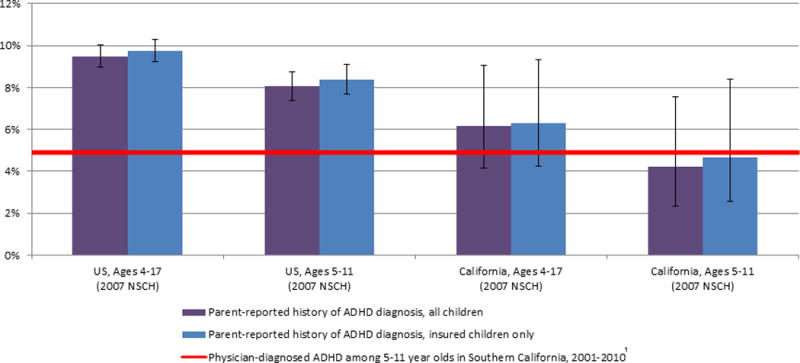To the editor
Getahun and colleagues recently published a study entitled “Recent Trends in Childhood Attention-Deficit/Hyperactivity Disorder” in which they used medical records and well-defined criteria to generate the prevalence of diagnosed attention-deficit/hyperactivity disorder (ADHD) in a large Southern California administrative sample.1 Their study contributes important geographically-based estimates of ADHD and draws conclusions about increasing ADHD prevalence within Southern California. However, the authors cited our previous research2 to support a commonly held assertion that parent- and teacher-reports of ADHD “overestimate true prevalence.” To date, parent-reported ADHD diagnosis on national health surveys has not been directly validated against a clinical standard, and thus needs further study before conclusions related to validity can be made. However, studies like that of Getahun may inform the evidence base for the validity of using survey data for monitoring ADHD over time. Our research estimated that the parent-reported prevalence of ADHD for children aged 4–17 years in California was 6.2% (2007)2, which may appear high compared to Getahun et al.’s estimate of 4.9% among children aged 5–11 in California (2001–2010). In this research letter we replicate our previous analyses of parent-reported ADHD with a sample more comparable to the Getahun study population.
Method
To allow for descriptive comparison, we revisited our previous analyses of data from the 2007 National Survey of Children’s Health (NSCH)2, further restricting the sample (73,123 children 4–17 years of age) to one more closely reflecting that of Getahun: specifically, children in California, 5–11 years of age, and covered by health insurance (n=590). The NSCH has two ADHD diagnostic indicators: one for having “ever” been told by a healthcare provider that a child had ADHD and the other for having “current” ADHD. The Getahun ADHD case definition was more reflective of a period prevalence rate than a point prevalence rate, suggesting that the “ever” diagnostic indicator was more appropriate for cross-study comparison. Prevalence estimates of the national, state-based, and age- and insurance-restricted NSCH survey estimates and 95% confidence intervals (CI) of parent-reported ADHD were calculated using SUDAAN3 to account for the complex sampling design.
Results
Based on NSCH data, nationally, 9.5% (95% CI: 9.0%–10.0%) of children aged 4–17 years had ever received a parent-reported ADHD diagnosis (Figure). This estimate was only slightly lower than, but statistically indistinguishable from, that of children with health insurance (9.8%, 95% CI: 9.2%–10.3%). Restricting the data to insured children 5–11 years of age, the national prevalence of children with a history of ADHD diagnosis dropped by 14.3%, to 8.4% (95% CI: 7.7%–9.1%). Further subsetting the age- and insurance-restricted analysis to children in California reduced the prevalence by 44.3% of the national rate, to 4.7% (95% CI: 2.5%–8.4%) of insured California children aged 5–11 years with a history of ADHD.
Figure.

Prevalence (%) and 95% confidence intervals of attention-deficit/hyperactivity disorder (ADHD) among children, by insurance status, geography, age, and data source
* NSCH = National Survey of Children’s Health
Comment
Upon initial inspection, the ADHD rate of Getahun and colleagues (4.9%) appears lower than previous2 national (9.5%) and California-based (6.2%) estimates of parent-reported ADHD. However, the analyses presented here confirm previous reports of the sensitivity of these estimates to insurance status, geography, and age.4–6 When considering these factors, the estimated prevalence of parent-reported ADHD in California closely approximates the rate of documented ADHD diagnosis in medical records of a Southern California population, with the Getahun rate falling within the 95% confidence interval of the NSCH estimate of ADHD among children in California, regardless of age. Therefore, in contrast to the authors’ statements that studies which rely on parent-reported cases of ADHD “overestimate true prevalence,” an alternative conclusion may be drawn from this study. Specifically, the Getahun study provides evidence of convergent validity that demonstrates the appropriateness of parent report for monitoring state-based and national prevalence of ADHD.
Acknowledgments
Ms. Visser had full access to all the data in the study and takes responsibility for the integrity of the data and the accuracy of the data analysis.
Contributor Information
Susanna N. Visser, National Center on Birth Defects and Developmental Disabilities, Centers for Disease Control and Prevention, Atlanta, GA.
Melissa L. Danielson, National Center on Birth Defects and Developmental Disabilities, Centers for Disease Control and Prevention, Atlanta, GA.
Rebecca H. Bitsko, National Center on Birth Defects and Developmental Disabilities, Centers for Disease Control and Prevention, Atlanta, GA.
Ruth Perou, National Center on Birth Defects and Developmental Disabilities, Centers for Disease Control and Prevention, Atlanta, GA.
Stephen J. Blumberg, National Center for Health Statistics, Centers for Disease Control and Prevention, Hyattsville, MD.
References
- 1.Getahun D, Jacobsen SJ, Fassett MJ, Chen W, Demissie K, Rhoads GG. Recent Trends in Childhood Attention-Deficit/Hyperactivity Disorder. JAMA Pediatr. 2013 Jan 21;:1–7. doi: 10.1001/2013.jamapediatrics.401. [DOI] [PubMed] [Google Scholar]
- 2.Centers for Disease Control and Prevention. Increasing prevalence of parent-reported attention-deficit/hyperactivity disorder among children — United States, 2003 and 2007. 2010 Reported by SN Visser, RH Bitsko, ML Danielson, R Perou, & SJ Blumberg. [PubMed] [Google Scholar]
- 3.SUDAAN. [computer program]. Version 10.0.1. Research Triangle Park, NC: RTI International; 2009. [Google Scholar]
- 4.Visser SN, Blumberg SJ, Danielson ML, Bitsko RH, Kogan MD. State-based and demographic variation in parent-reported ADHD medication rates, 2007–2008. Preventing Chronic Disease. 2013;10:20073. doi: 10.5888/pcd9.120073. [DOI] [PMC free article] [PubMed] [Google Scholar]
- 5.Pastor PN, Reuben CA. Diagnosed attention deficit hyperactivity disorder and learning disability: United States, 2004–2006. Vital Health Stat 10. 2008 Jul;(237):1–14. [PubMed] [Google Scholar]
- 6.Zuvekas SH, Vitiello B. Stimulant medication use in children: A 12-year perspective. American Journal of Psychiatry. 2012;169(2):160–166. doi: 10.1176/appi.ajp.2011.11030387. [DOI] [PMC free article] [PubMed] [Google Scholar]


